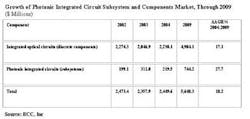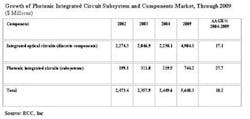Photonic IC subsystems and components market pegged at $5.6 billion by 2009
October 20, 2004 Norwalk, CT -- According to a soon-to-be-released report from Business Communications Company, Inc., RGB-256R Photonic Integrated Circuits: New Directions, the market for photonic integrated circuit (PIC) subsystems and components is currently estimated at $2.5 billion. Expected to grow at an average annual growth rate (AAGR) of 18.2%, this market is estimated to reach nearly $5.7 billion by 2009.
Since the introduction of PICs in 1997, the optical component industry has slowly been migrating from the manual assembly of discrete optical devices to automated, semiconductor wafer-processing techniques and single-chip solutions. Yet in the last three years, the market has undergone a major realignment. About 75% of photonic chip makers have either merged or closed down since 2001, the carrier market has undergone a number of bankruptcies and consolidations, and a slowdown in equipment spending in the long-haul market is not expected to rebound before 2006. Amid this repositioning, product pipelines of market-ready advanced photonic chips and growing end market demand have emerged.
Separately, the market for discrete devices or integrated optical circuits will grow from a current estimated market value of $2.2 billion to $4.9 billion by 2009. The established transmission market (laser diodes, transmitters, photodiodes) composes 77% of this market. The market for subsystems, or PICs, will grow at an AAGR of 27.7% to reach $744 million by 2009. In sum, these systems, or optical systems-on-a-chip (SoC), will grow from 9% to 13% of the overall market for PIC subsystems and components during this forecast period.
PIC sales have experienced a slight generational lag due to the protracted slowdown in telecom equipment spending that began in 2001. In the 2001-2003 recession, sales fell as much as 60% across optical component product lines as suppliers strived to work down excess inventories amid bandwidth overcapacity. Yet the resultant focus on the bottom line has a silver lining. The value of higher-performing, low-cost optical components in the network has increased.
Previous market forecasts underestimated the length and severity of the downturn in telecom spending. The high debt loads of the carrier market and its inability to restructure in a timely fashion has weighed down on optical component sales. BCC believes the cycle low was reached in 2003. The optical component industry is on track to grow 10% in 2004. A strong rebound will be driven by growth in Internet traffic and bandwidth-intensive services, such as video on demand and gaming. Higher growth in emerging markets includes the build out of networks in Asia and other emerging markets and the untapped potential in the metro and access markets.
Underpinning this forecast is a number of shifting dynamics affecting fiber-optic telecommunications equipment spending. Specifically:
- DWDM has changed the telecom equipment spending business cycle. The rebound, gaining modest traction in 2004, will span 24 months while bandwidth overcapacity is worked down, resulting in a longer cycle downturn.
- The long-haul market build out is nearing completion. Future demand growth will come from the metro and access markets, which will require more advanced yet lower-cost components. These markets will grow at more than twice the rate of long haul over the next five years.
- Future growth will be tied to new services such as DSL rather than optical backbone build out. These services are being rolled out at a faster clip, yet still below the well-funded boom by low-cost capital of the long-haul market build outs from 1995-2001.

